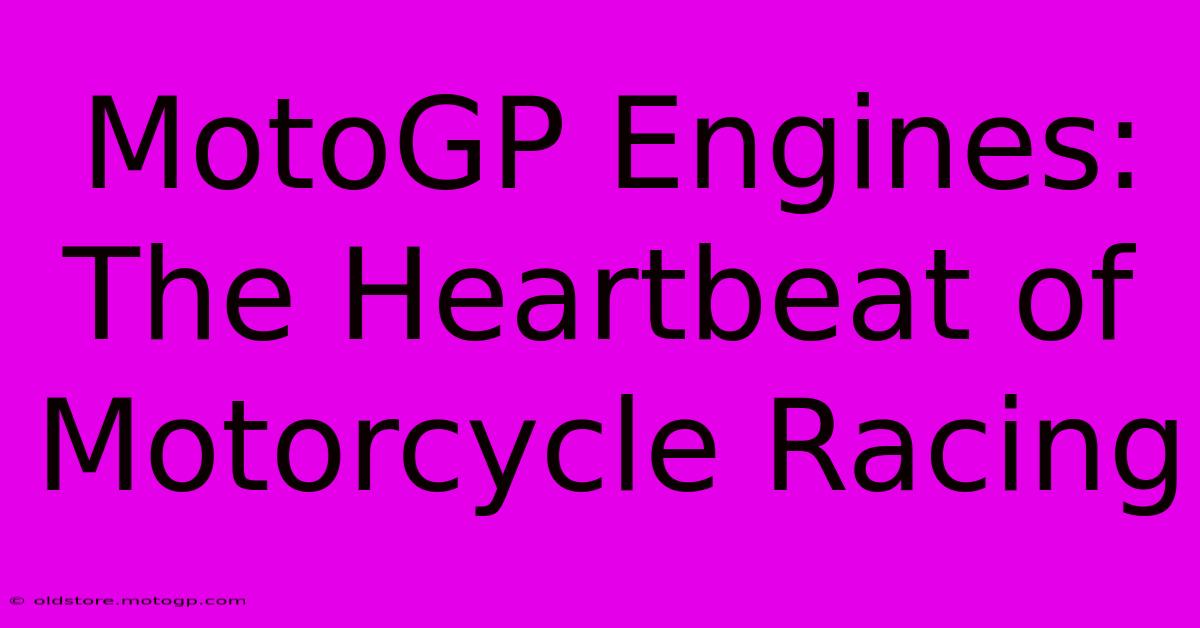MotoGP Engines: The Heartbeat Of Motorcycle Racing

Table of Contents
MotoGP Engines: The Heartbeat of Motorcycle Racing
MotoGP, the pinnacle of motorcycle racing, is a spectacle of speed, skill, and technological marvel. At the heart of this thrilling competition lies the engine – a finely-tuned masterpiece of engineering that pushes the boundaries of performance. This article delves deep into the world of MotoGP engines, exploring their intricacies, evolution, and the relentless pursuit of power and efficiency.
The Powerhouse: A Deep Dive into MotoGP Engine Specifications
MotoGP bikes boast incredibly powerful engines, currently limited to 1000cc four-stroke prototypes. These aren't your everyday motorcycle engines; they are highly specialized, meticulously crafted powerhouses designed for maximum performance on the track. Let's break down some key specifications:
- Engine Type: Four-stroke, four-cylinder (mostly inline, but some variations exist). The inline configuration is preferred for its compact size and efficient power delivery.
- Displacement: 1000cc (with strict regulations on bore and stroke limits to maintain a level playing field).
- Power Output: While exact figures aren't publicly released by manufacturers, estimates place peak power output well over 260bhp, even reaching closer to 280bhp in some cases. This is achieved through incredibly high RPMs, often exceeding 16,000 rpm.
- Fuel Injection: Sophisticated fuel injection systems precisely meter fuel delivery for optimal combustion, ensuring maximum power and efficiency. This is crucial for managing fuel consumption under intense racing conditions.
- Materials: Lightweight and high-strength materials, such as titanium, magnesium, and carbon fiber, are extensively used to minimize weight while maximizing durability. This reduction in weight is critical for handling and speed.
- Electronics: Sophisticated electronics play a vital role, managing everything from fuel injection and ignition timing to traction control and launch control. These systems allow riders to fully exploit the engine's potential, enhancing performance and safety.
Evolution of MotoGP Engines: From Two-Strokes to Four-Strokes
The history of MotoGP engines is a story of constant evolution. The early days of the sport were dominated by two-stroke engines, known for their high power-to-weight ratio. However, environmental concerns and advancements in four-stroke technology led to a switch in 2002. The transition to four-stroke engines marked a significant shift, necessitating a complete rethinking of engine design and technology. This transition also led to a fascinating evolution of engine technology, driving constant innovation and improvements. Today, we're seeing the incredible sophistication and power of modern four-stroke MotoGP engines.
The Quest for Performance: Engineering Innovations in MotoGP Engines
The pursuit of ever-greater performance is a constant drive within MotoGP engine development. Manufacturers employ a range of innovative techniques:
- Pneumatic Valves: Some manufacturers explore pneumatic valve systems, offering potentially faster valve actuation and higher RPM capabilities.
- Variable Valve Timing: This technology optimizes valve timing across the engine's rev range, maximizing power and efficiency at various speeds.
- Aerodynamics: While not strictly part of the engine, aerodynamic improvements to the bike's overall design directly affect engine performance and top speed.
Beyond the Numbers: The Human Element
While the technological prowess of MotoGP engines is undeniable, it's essential to remember the human element. Highly skilled engineers and technicians dedicate countless hours to designing, building, and maintaining these machines. The synergy between human ingenuity and technological advancement is what truly makes MotoGP engines so impressive.
Conclusion: The Future of MotoGP Engines
The future of MotoGP engines promises even greater advancements. The continued push for increased performance, improved efficiency, and reduced emissions will undoubtedly lead to further innovations in engine design and technology. The heartbeat of motorcycle racing continues to beat strong, propelled by the relentless pursuit of speed and perfection. The future of this technology promises to be even more exciting and innovative than the advancements we've seen thus far.

Thank you for visiting our website wich cover about MotoGP Engines: The Heartbeat Of Motorcycle Racing. We hope the information provided has been useful to you. Feel free to contact us if you have any questions or need further assistance. See you next time and dont miss to bookmark.
Featured Posts
-
Moto2 Bikes The Choice Of Champions
Feb 25, 2025
-
Famous Motorcycle Riders Who Conquered The World
Feb 25, 2025
-
Cota Motorcycle Track Days Fuel Your Passion
Feb 25, 2025
-
Austin Gp 2025 Inspiring The Next Generation
Feb 25, 2025
-
Moto3 Bikes The Ultimate Guide To Lightweight Racing Technology
Feb 25, 2025
